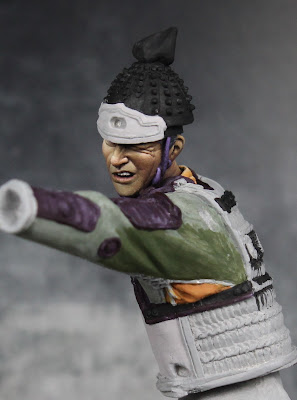Well, this is not a major update... but since I'll be away from the painting table for the next few days I thought I'd share what I've done on the samurai in the past few days. These are all cell phone pictures from my painting station (no light box setup or anything), but I will hopefully return to the more polished pictures next time.
Having finished the chest armor, I'm now turning to his arm. These are just the first few steps, but I thought it would be interesting to show in a little more detail how I start on a different complex pattern. The background color for this one will be green. I wasn't especially happy with the shading/highlighting you saw in the last two posts, so I redid the sleeve. Even though I will be painting over a lot of it with the pattern, I like to have a good base to work on. On some patterns I will do the background color and the pattern color at the same time (or at least sketch in the pattern before shading/highlighting the background). It really depends on the design and what I feel will be easier. This one will involve a lot of thin lines, so it's easier for me to do the background first.


As for the pattern, I did a lot of searching through reference books and online. I finally happened upon this pattern. It's similar enough to the first one that I think they will look good together, but different enough to be a distinct design. The white circles with the floral designs also gives me some more stuff to work with.
It's not that easy to really understand what's going on because of all the folds. But I spent some time analyzing it here and in another picture of the same person/outfit. As far as I can tell, this is how the pattern actually looks.

Now I'm finally ready to start transferring it to the figure. What you see above will be rotated 45 degrees on the figure. So I began with the main diagonal lines above and lightly painted on horizontal lines down the arm. I got a rough idea of the spacing I wanted and created a guide to keep it consistent. I then painted white dots (halfway between the horizontal lines) at where I thought the center of the circles should be. Again, I used the same measuring guide to space them. Because of the folds in the sleeve, I adjusted the spacing as I saw fit. Then I started to paint in the main vertical lines (other half of the diagonals above). These got a bit titled do to the movement and stretching of the cloth. Finally I put in the diagonal lines between the dots (horizontal and vertical in the image above). I still need to add in another two lines between each of the diagonals and fill out the rest of the circles, but this is a good point to stop and evaluate the design and spacing. You can see I've already made some adjustments (notice the double white dots in places). I will continue to turn the figure and view the pattern from different angles to check it and make adjustments where needed. Once I'm happy with it, I'll fill in the remaining lines, draw the circles to scale, and start shading/highlighting all of the design.





























